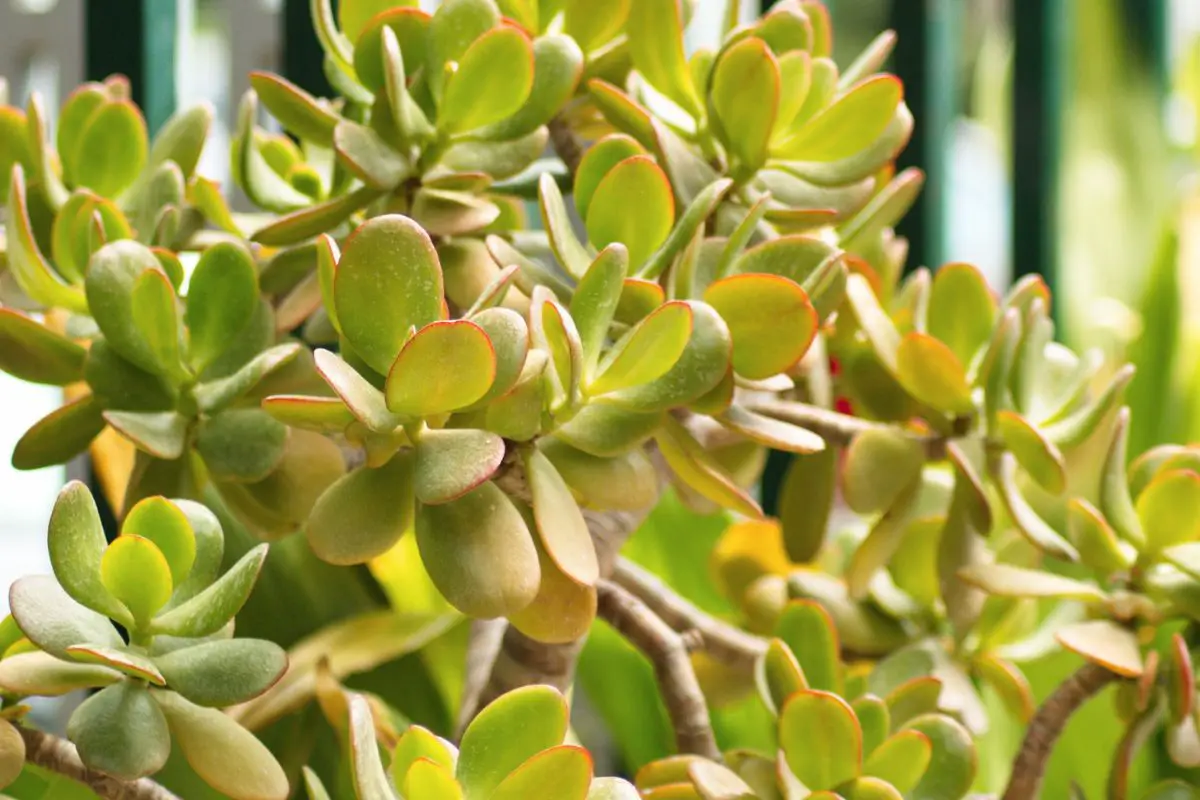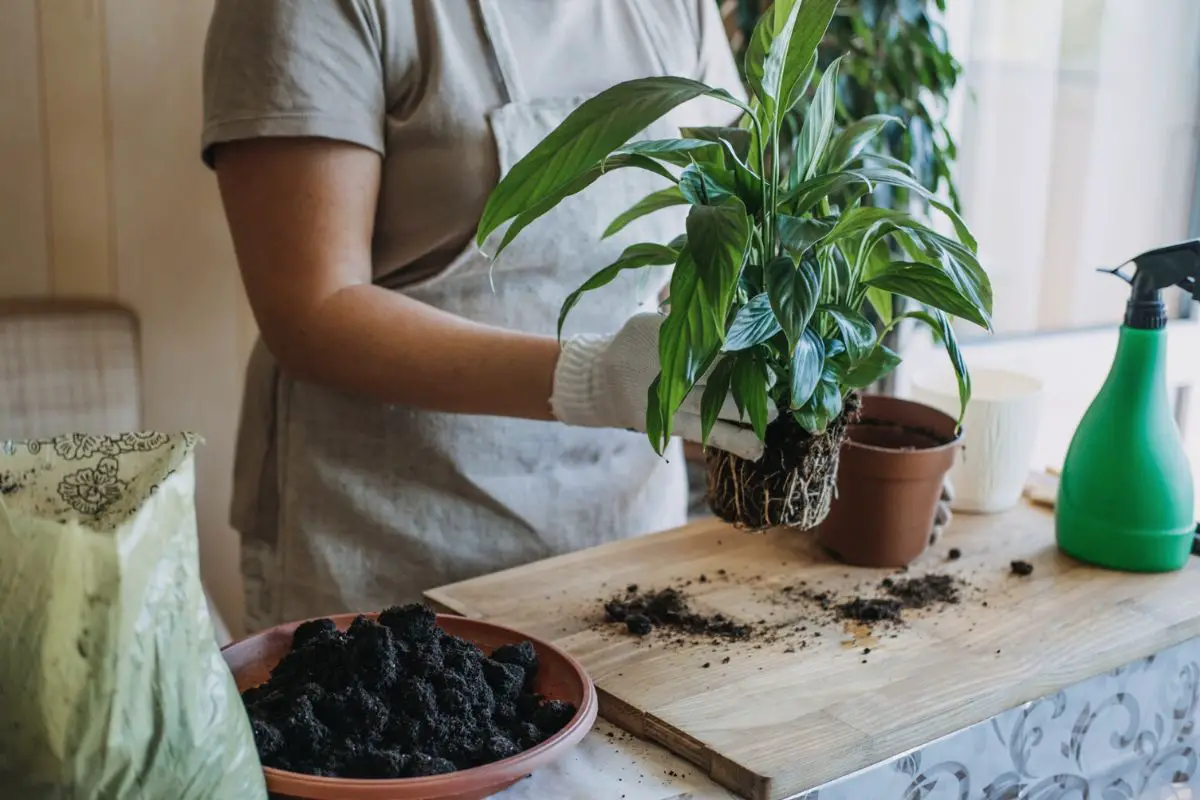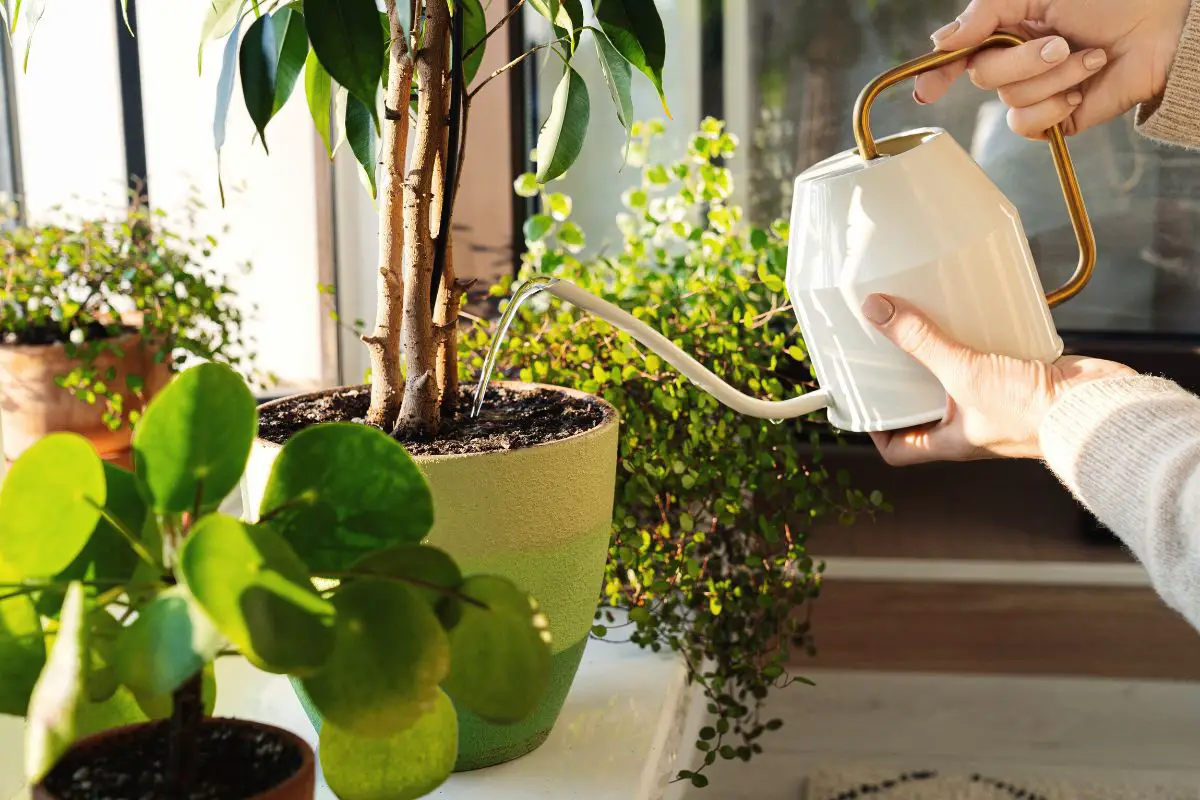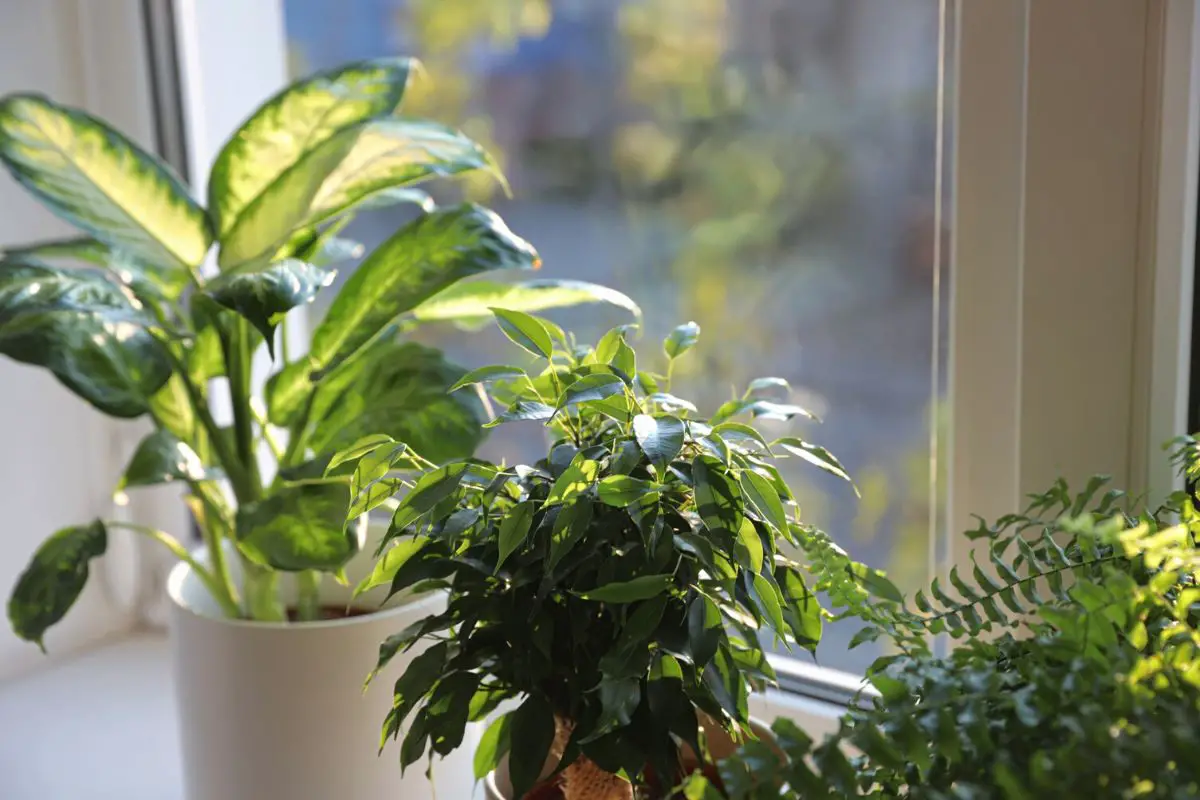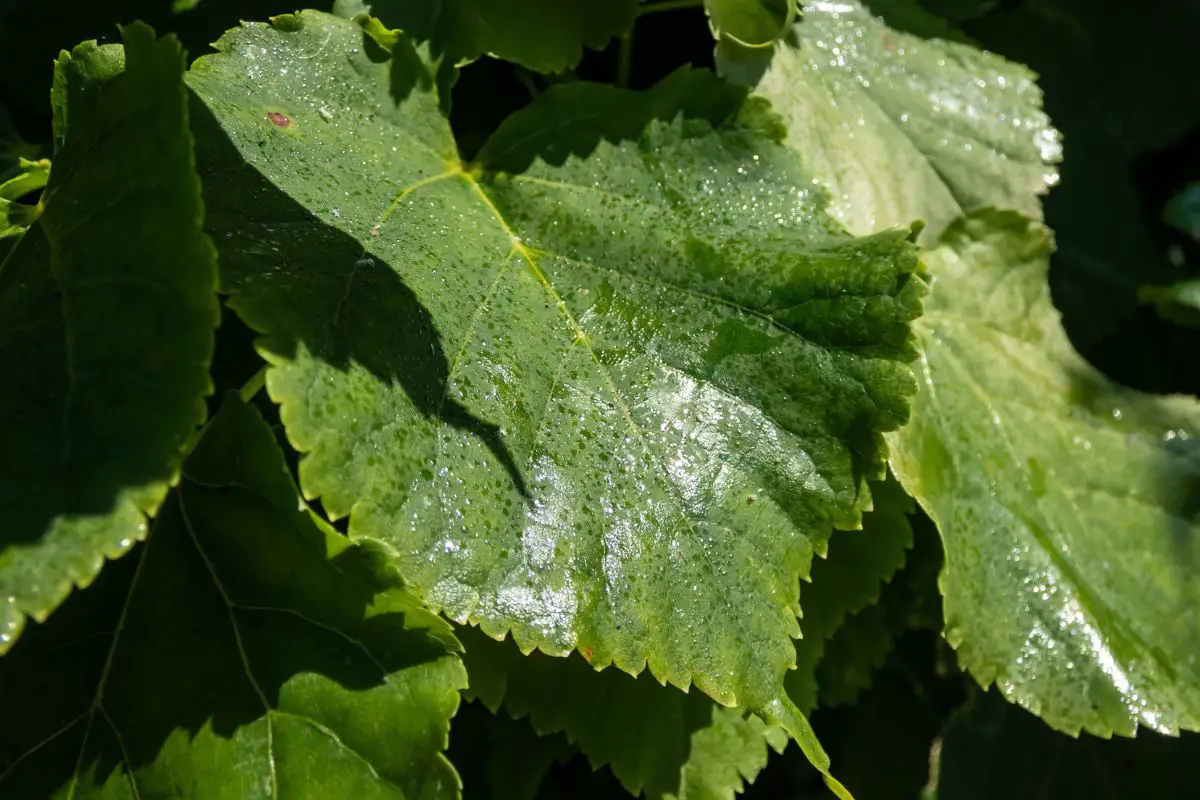Jade plants (Crassula ovata) are popular for their succulent coin-shaped leaves. They’re widely believed to bring good fortune, earning them the nickname “Money Plant.” In addition, they have low-maintenance needs and can live up to a hundred years.
To grow jade plants in your home, you need a spot that receives at least 4 hours of direct sunlight. They thrive in moderate humidity levels of 30-50%, temperatures between 65 and 75 °F (18 and 24 °C), infrequent watering, and fast-draining soil.
This article will detail everything you need to know about jade plants, including planting tips and care requirements. I’ll also discuss common problems you might come across when growing jade plants and share practical solutions.
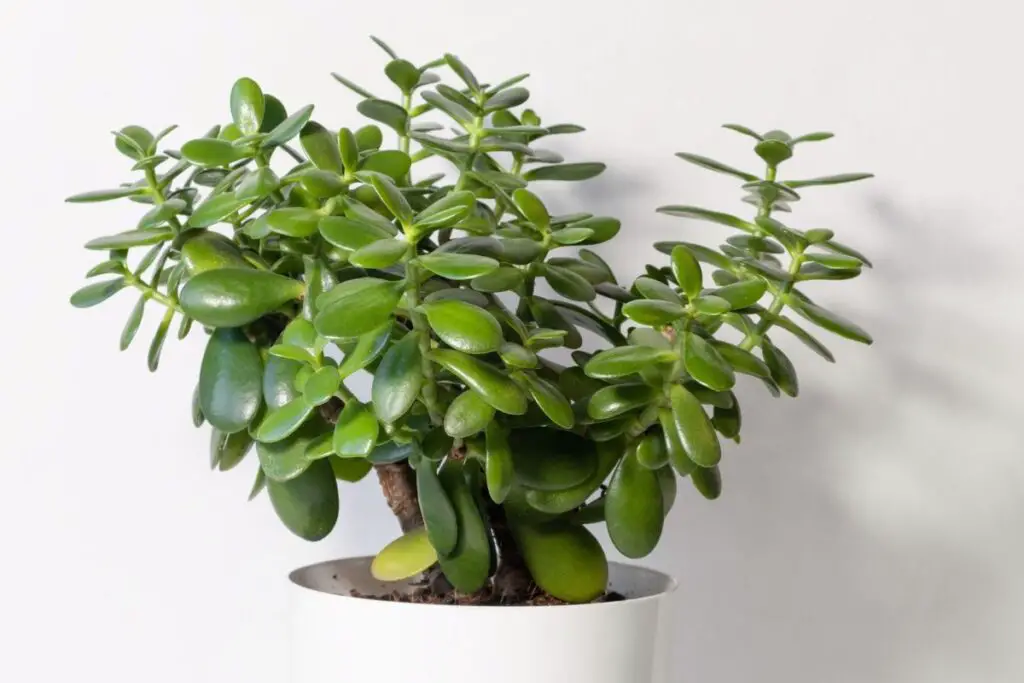
Quick Guide
| Common Name(s) | Jade plant, money plant |
| Botanical Name | Crassula ovata |
| Family | Crassulaceae |
| Plant Type | Succulent, shrub |
| Native Area | South Africa |
| USDA Hardiness Zone | 10-12 |
| Height & Spread | 3-6 feet (0.9-1.8 m) tall 2-3 feet (0.6-0.9 m) wide Dwarf varieties are less than 3 feet (0.9 m) tall |
| Bloom Time | Winter |
| Flower Structure | Cyme |
| Color | Jade to dark green, variegated, or red/yellow leaves White or pinkish flowers |
| Sun Exposure | Full sun to partial sun At least 4 hours of direct sunlight |
| Soil Type | Loose, fast-draining |
| Soil pH | 6.0-7.0 |
| Watering | Every 10-14 days When the top half of the pot is dry When the leaves fold when squeezed |
| Pests, Diseases, Common Problems | Mealybugs, scale mites, spider mites Root and stem rot, bacterial soft rot, powdery mildew Leaf scorch, lack of flowers, red leaf tips, stunted growth, leggy stems |
| Toxicity | Mildly toxic to kids and pets Ingestion of leaves can cause vomiting, diarrhea, stomachache, unsteady gait |
| Required Maintenance | Low |
Jade Plants: An Overview
Jade plants are succulents native to semi-arid or subtropical regions of South Africa, such as Eastern Cape and KwaZulu-natal. They’re mostly found in slopey areas or low, shrubby forests with loose soil.
Below are the key points in their native environment and physical traits that are crucial to understanding their care requirements in colder climate zones:
- Unobstructed sun: Mature jade plants receive an average of 8 hours of unobstructed sunlight daily in the wild due to low-growing neighboring plants. Younger ones are typically shaded by nearby shrubs.
- Hot and wet summers: Higher summer temperatures of 70-90 °F (24-32 °C) are compensated by more frequent rains, reducing the risk of heat stress. In home or outdoor gardens, this can be replicated by more frequent watering in the summer.
- Rainfall pattern: In their home environment, jade plants receive sufficient rainfall during spring and summer. In the fall and winter, they receive shallow, infrequent rains.
- Shallow roots: The rainfall pattern discussed above influenced the plant to grow shallow roots to quickly soak up water as it moistens the soil surface.
- Succulent leaves: Their scientific name ‘ovata’ means egg-shaped, which refers to the rounded, plump leaves. These leaves have a waxy, turgid texture allowing them to store extra moisture during dry periods. They’re usually 1-4 inches (2.5-7.6 cm) long and 1-2 inches (2.5-5 cm) wide.
- Thick trunk: Jade plants need a thicker trunk to withstand the pull of gravity in slopey areas and support the weight of the thick, heavy foliage. In home environments, you need to prune your plants regularly to encourage them to develop a tree-like trunk and branches.
- Frost-free winters: Winter temperatures in their native environment seldom drop below 50 °F (10 °C). Therefore, they will sustain cold injury when exposed to temperatures below 40 °F (4 °C) for extended periods.
- Flowering: Exposure to 2-3 months of semi-dry fall conditions (scarce rains) and cool temperatures below 65 °F (18 °C) encourages mature jade plants to produce flowers in winter.
Symbolism and Significance
A classic jade plant’s physical traits give it significant value in Feng Shui. The jade-colored, coin-shaped leaves symbolize financial luck. Its thick trunk and evergreen leaves symbolize stability, which translates to continuous good fortune.
However, these symbolisms don’t apply to jade plant varieties that have colored leaves, bushy growth with soft stems, or tubular leaves (i.e., ‘Gollum’ and ‘Skinny Fingers’).
The positioning of jade plants in your home also influences how much good luck it can bring.
Ideally, you should place them in east- or north-facing spaces, such as entryways and living rooms, because this will attract good energy to your home. However, in the northern hemisphere, north-facing spaces receive the least amount of sunlight, making them unsuitable for sun-loving jade plants.
Whenever possible, position your jade plants next to a bright, eastern window for a balance in plant health and good fortune.
A south-facing window, on the other hand, is optimal for jade plants for practical reasons, especially in colder climate zones where summers are short.
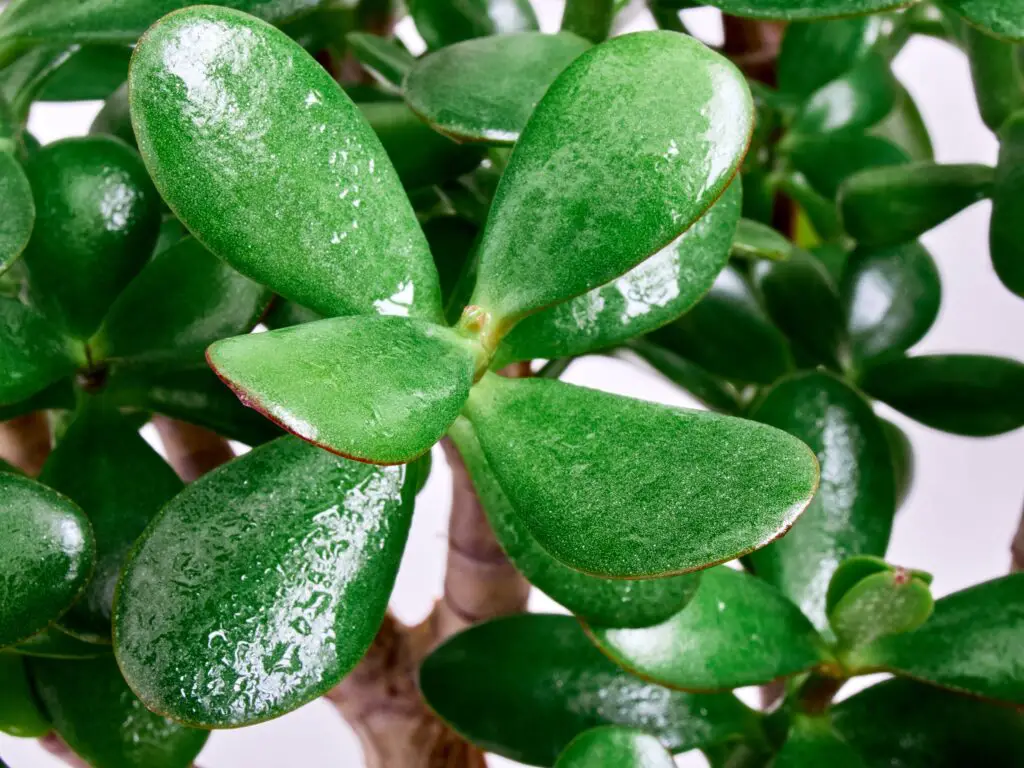
Potential Toxicity
Jade plant leaves are culturally used as herbal medicine.
In India and South Africa, the leaves are pounded or squeezed and the juice is applied to remove warts or heal wounds. In Chinese culture, jade leaves are brewed to make tea to cure diabetes or relieve stomach pains or nausea.
However, more research is necessary to confirm the proper method of extracting beneficial components and isolating the toxic compounds.
Direct consumption or ingestion of unprocessed leaves can cause the following symptoms, especially in young kids, cats, and dogs:
- Stomach pain
- Nausea
- Vomiting
- Diarrhea
- Unsteady gait
Keep your plant beyond the reach of children and dogs. If you have cats, you must place your jade plant in a separate room inaccessible to them.
Selecting Your Jade Plant
There are plenty of jade plant varieties to choose from, depending on your preferred indoor garden aesthetic.
Here are some popular options if you want something more fun than the classic jade plant:
| Variety | Physical Traits |
| Gollum | It has tubular leaves with a hollow space in the middle that opens on the tips. The rim of the openings may appear red if the plant is exposed to direct sunlight for over 4 hours. It’s more compact at only 3 feet (0.9 m) tall at maturity. |
| Red Coral | It has tubular leaves that first appear green and eventually transition to yellow with red tips. The bright colors are more likely to appear when you grow your plant in direct sunlight for 4-6 hours daily. This variety also grows to 3 feet (0.9 m) tall. |
| Hummel’s Sunset | The leaves are similar in size and shape to the classic jade but they take on yellow, orange, and red hues in winter. It typically grows 2-3 feet (0.6-0.9 m) tall. |
| Minima (Miniature Jade) | It resembles the classic jade but has smaller leaves about 1 inch (2.5 cm) long and ¾ inch (1.9 cm) wide. It grows to only 2.5 feet (0.75 m) tall. |
| Campfire | The leaves are less plump and almost lanceolate in shape. They’re arranged in a rosette-like formation along the stems or branches. The green leaves become yellow and red as they get bigger if exposed to direct sunlight. It reaches only 6-8 inches (15-20 cm) at maturity. |
Tips for Purchasing Quality Plants
If you’re purchasing a jade plant from the nursery or garden center, keep the following tips in mind for the best value for your money:
- Choose a young plant between 1 and 2 years old. It has young stems that you can later train to grow bushy or tree-like.
- Choose a plant with sturdy stems that grow upright. Jade plants need strong stems to support the dense foliage. Alternatively, choose one with a distinct central trunk or stem that you can keep later if you want a tree-like growth pattern.
- Inspect the leaves’ appearance. Healthy jade plant leaves are plump and firm. Wrinkled or scorched leaves indicate that they have been underwatered or exposed to intense heat or dry conditions for extended periods. Although it will likely bounce back with repotting and deep watering, you wouldn’t want to get a stressed plant because it’ll be more vulnerable to pest problems.
- Test the stability of the leaves. A jade plant is sensitive to overwatering and will shed even healthy-looking leaves when stressed. Give the leaves a gentle tug to see if they fall off readily. This indicates that the plant is in poor health.
- Avoid pest-infested plants. Mealybugs are the most common pests of jade plants and they usually hide underneath the leaves or along the stems. You can identify these crawlers through their white, cottony covering.
After bringing home your new plant, isolate it for up to 8 weeks to ensure no pest eggs or larvae are hiding in the soil.
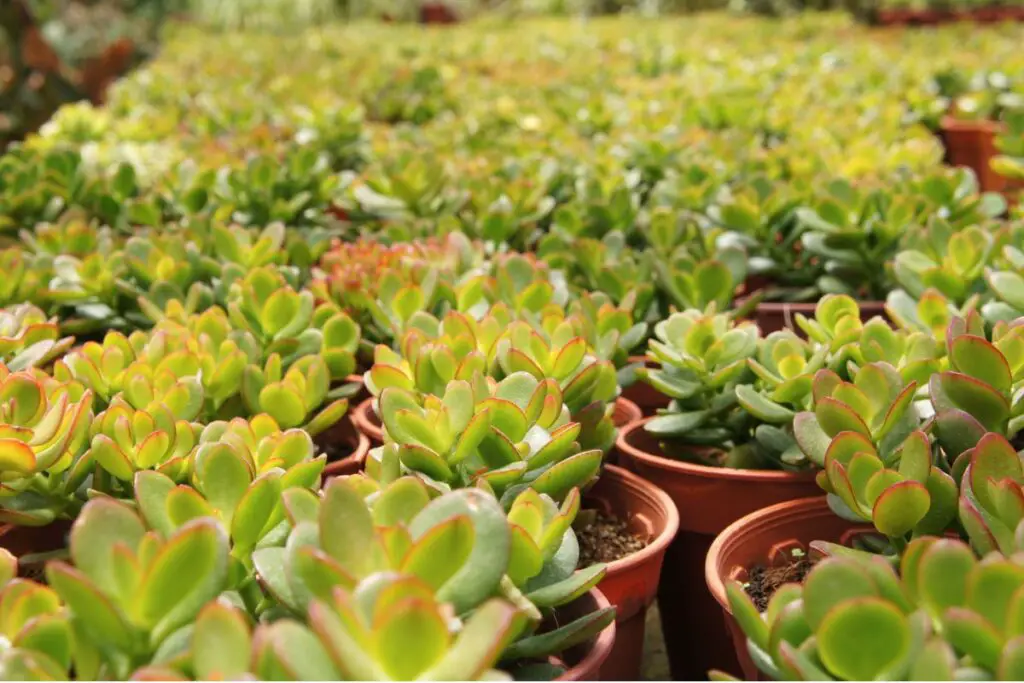
Initial Planting
After purchasing your jade plant, you can keep it in the same pot and soil for up to a year. Wait until the following spring for initial repotting.
Selecting the Appropriate Soil
Jade plants need well-draining soil because their shallow, fibrous roots are susceptible to rot when kept in constantly wet soil. You can use a standard succulent mix for potted jade plants.
You may also use either of the following homemade recipes:
- Equal parts standard potting soil, coarse sand, and perlite/pumice
- Equal parts compost and perlite
Jade plants require infrequent watering. If sandy soil dries out completely between watering sessions, there’s a risk of becoming hydrophobic.
Standard potting soil typically contains peat and loam, which can hold a bit of moisture. Adding potting soil or compost to the soil mix of jade plants ensures that the substrate will be easy to re-wet.
If you live in a frost-free region (USDA zones 10-12), you can grow jade plants in the ground.
Follow these tips to select a spot and amend the soil:
- Choose a spot that receives unobstructed sunlight for 4 hours daily. In hotter climates, ensure the plant receives shade from the midday sun.
- Dig out the top 6-8 inches (15-20 cm) of garden soil. The width should be twice the size of the rootball.
- Mix the extracted soil evenly with coarse sand.
- Fill the mixture back into the hole at planting.
Choosing the Correct Container
Here are the things to consider when choosing the container for potted jades:
- The pot must be heavy (i.e. terracotta) to support the top-heavy plant.
- Use a pot with drainage holes to remove excess water and prevent water-logging.
- A breathable pot will help dry out the soil faster. You can still use glazed, decorative containers as long as they have drainage holes.
- Choose a pot that’s 2 inches (5 cm) wider and deeper than the old one. If transplanting to a similar-sized pot, you must prune the roots.
Step-by-Step Planting Guide
Most nursery plants come in plastic pots.
Here are the steps to carefully unpot them:
- Water the plant deeply 2 days before transplanting.
- Moisten the new substrate or water the ground deeply (depending on where you want to move your jade).
- Firmly squeeze the pot to loosen the soil.
- Hold the trunk with one hand and slide the rootball out of the pot.
- If the soil doesn’t slide out, run a spatula or a flat knife along the sides of the pot to loosen the rootball. Try to slide the plant out again.
Inspect for signs of rot, such as black, mushy, and smelly roots. In contrast, white tips are good signs of growth.
If there’s rot, follow the additional steps below:
- Put on a pair of gloves and loosen the soil.
- Use sharp, sterile scissors to remove the damaged or decayed roots.
- Leave the plant unpotted for around 3 days in a cool, dry room away from direct sunlight until the cut roots form a callus. I recommend a spot that’s around 70 °F (21 °C) with 30-40% humidity.
Transplanting in a New Pot
- Place enough fresh, moist soil at the bottom of the new pot so that the plant’s crown is ½-1 inch (1.3-2.5 cm) below the rim of the pot.
- Secure the plant in the middle of the pot and fill in the gaps with more soil.
- Tamp the soil down to remove air pockets and keep the plant upright.
- Place the pot in the same spot as the old one.
- Wait one week or until the top half of the pot is dry before watering your plant deeply.
Planting into the Ground
- Dig a hole as deep as the rootball but twice as wide.
- Place the plant into the hole and fill the gaps with soil, covering the crown with half an inch (1.3 cm) of soil.
- Water the ground deeply. Properly amended garden soil will dry out fast, especially when exposed to direct sunlight and occasional winds.
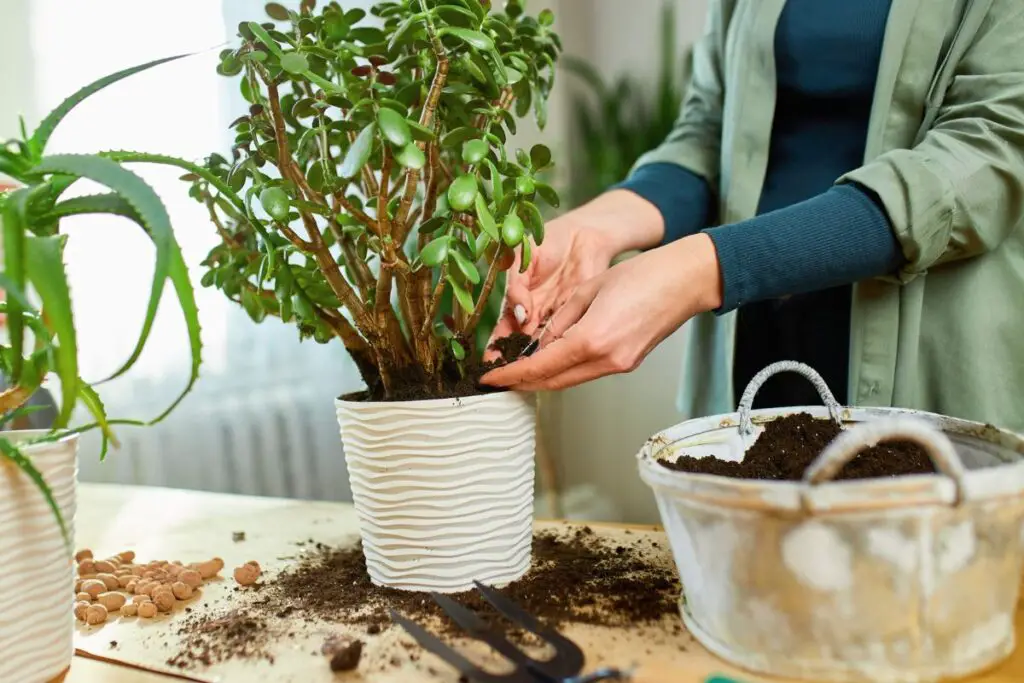
Optimal Growing Conditions
Jade plants grow slowly when kept indoors. It’s crucial to provide optimal growing conditions to encourage your plant to grow faster, remain healthy, and even bloom.
Light
Jade plants prefer a sunny spot next to an eastern window where they can receive direct but gentle morning light.
Colored jade cultivars will bring out their characteristic colors when they receive at least 4 hours of direct sunlight. Exposure to unobstructed sunlight during spring and summer can also promote flowering in winter.
Classic green jade plants will have red leaf tips when exposed to similar conditions. Classic jades retain their deep green foliage and variegated cultivars produce variegations when kept in bright, indirect light all day, such as 5 feet (1.5 m) from a bright southern window.
Rotate potted jades by 90-180° every time you water them to avoid leaf scorch or sunburn.
For jade plants grown in garden soil, you can install shade covers at midday, especially at the peak of summer.
Temperature
Jade plants thrive at temperatures between 65 and 75 °F (18 and 24 °C), which is easier to maintain indoors.
When grown outdoors in hotter climates, jade plants can tolerate summer temperatures around 85-90 °F (29-32 °C) if watered more frequently (i.e., every 5-7 days).
Cover them in burlap when nighttime temperatures are expected to fall below 40 °F (4 °C) in the fall or winter.
Humidity
Jade plants do well at humidity levels between 30 and 50%.
Avoid higher levels, which can promote fungal growth, such as mold and mildew, on the leaves. You can lower the humidity by improving air circulation and pruning the dense foliage.
Conversely, if the area is dry, you can raise the local humidity by grouping succulents with similar environmental needs. Great aesthetic and functional companions to jade plants are haworthias and euphorbias.
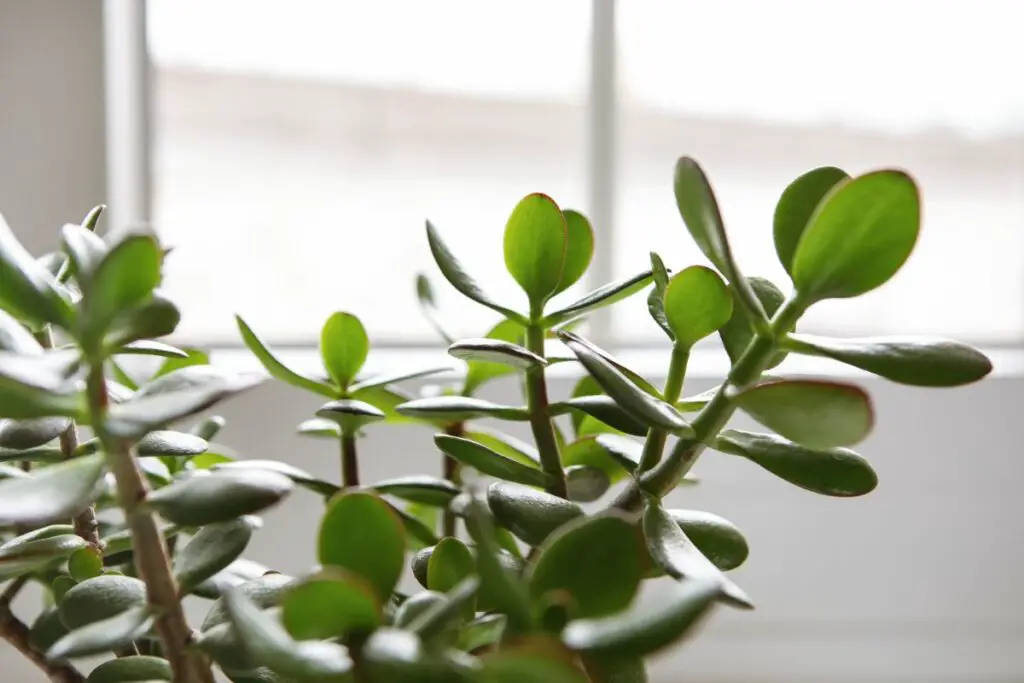
Watering
As succulents, jade plants are drought-tolerant. It can take 6 weeks or so of underwatering in spring or summer before they show signs of stress. Conversely, they’re more sensitive to overwatering and will suffer root and stem rot when frequently overwatered.
Here are the symptoms of watering problems in jade plants:
| Underwatering | Overwatering |
| Wrinkled leaves | Lower leaves turn yellow or pale first |
| Terminal leaves turn yellow | Brown or black wet spots or lesions |
| Brown and dry leaf tips | Leaf drop (healthy or discolored leaves) |
| Leaf drop (dried leaves) | Soft, mushy stems |
| Drooping or wilting stems or branches | Black, smelly roots |
| Stunted growth |
You can treat underwatered jade plants by watering the soil deeply. If the soil has become hydrophobic, you can soak the pot in a tub of water for 10-30 minutes to rehydrate it. Alternatively, you can repot the plant in fresh soil.
On the other hand, overwatered plants with severe leaf damage or signs of root rot must be repotted in fresh soil with better drainage. You must prune the damaged roots before repotting.
In severe cases, the only solution is to propagate the remaining healthy leaves or stems. I’ll discuss these in more detail below.
My jade plants thrive in the following watering schedules:
- Spring: Every 2-3 weeks
- Summer: Every 10-14 days; 5-7 days in direct sun outdoors
- Fall and winter: Every 4-6 weeks
These frequencies can vary depending on the environmental conditions and soil quality your plant is exposed to.
Jade plants are resilient succulents that don’t mind completely dry soil between watering sessions. The only downside is that the substrate (which typically contains a lot of sand) can be hard to re-wet when allowed to become bone-dry too frequently.
To avoid watering problems, you can use these tips:
Soil Moisture Test
Around 7-10 days after watering, check the soil moisture by poking a wooden chopstick into the soil.
Water your potted jade plant when the upper half of the potting mix is dry. On the other hand, in-ground jades need water when the top 2-3 inches (5-7.6 cm) of the soil is dry.
Squeeze Test
You can squeeze the leaves and see if they fold or bend. Jade leaves are turgid and resistant to pressure from squeezing when well-watered. If they fold from the pressure between your fingers, it’s a good sign that you need to water your plant deeply.
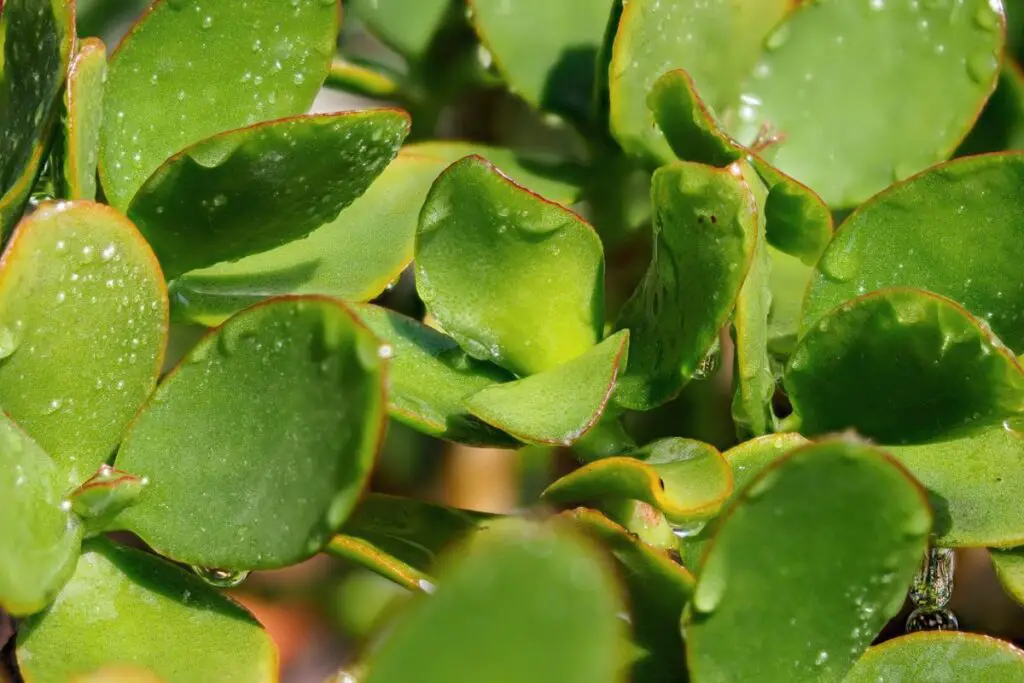
Fertilizing and Nutrient Requirements
Jade plants naturally live in poor soil but may grow slower. They seldom show signs of nutrient deficiency.
However, if grown in the same pot for several years without supplemental fertilizer, they will likely show the following signs:
- Dwarfing or stunted growth
- Yellowing leaves (lack of nitrogen)
- Lack of flowers (lack of phosphorus)
It’s crucial to rule out watering or sunlight problems before feeding your plant because overfertilization can worsen your plant’s stress. You can use an at-home test kit to check the soil NPK levels.
Once you confirm that the issue is due to nutrient deficiency, feed your plant with a balanced 10-10-10 fertilizer with trace amounts of micronutrients.
Apply the fertilizer from spring to summer in the following frequencies:
- Slow release granular fertilizer: Once every two months
- Quarter- or half-strength liquid fertilizer: Every time you water your plant (i.e., once every 2-3 weeks)
Pruning and Maintenance
Here are the different purposes of pruning jade plants:
- Maintaining the shape of the foliage or canopy
- Removing damaged or stressed foliage
- Improving air circulation
- Getting a thicker, tree-like trunk
- Training your tree into a bonsai
For routine maintenance (the first three items listed above), you can follow these tips:
- Pinch new shoots anytime if they sprout in unwanted spots along the main trunk or larger branches.
- Remove dried-out or discolored leaves but limit pruning to less than a third of the plant. Wait at least 2 weeks—ideally after watering—before removing another batch of damaged foliage.
- After maintenance pruning, dust the remaining leaves using a soft, moist cloth. You can repeat this on the same day you water your plant to prevent dust buildup and routinely check your plant’s health.
On the other hand, spring is the best time to hard-prune jade plants for thicker trunks or bonsai training.
Pruning for a Tree-Like Trunk
For this purpose, you’ll need the following materials:
- Sterile shears
- Bamboo stake at least a half inch (1.3 cm) in diameter; the length should be equal to the depth of the pot plus the height of the trunk
- Velcro garden tape (½ inch or 1.3 cm) or soft twist ties
Here are the steps to encourage a thicker main trunk on your jade plant:
- Choose the sturdiest stem to turn into the main trunk.
- Cut down the other stems to an inch (2.5 cm) above the soil to prevent rot.
- Cut back the main trunk’s lower lateral branches using sterile shears.
- Prune about ⅓ of the foliage to your desired shape. New shoots will grow out later.
- Bury the bamboo stake all the way down, about an inch (2.5 cm) away from the trunk. Avoid damaging too many roots by twirling the stake between your fingers as you insert it into the soil.
- Secure the stem against the stake using a soft twist tie or Velcro tape. Ensure the tie or tape doesn’t dig into the surface of the stem.
- Adjust the tie as the stem gets wider or longer.
- Pinch any unwanted shoots sprouting.
- Prune the lower branches as new growth emerges on top if you want a longer trunk.
- Trim the unwanted branches but limit removal to less than a third of the volume.
- Remove the stake and tie when the trunk is significantly thicker and can hold the weight of the foliage. This can take a few years.
Training for a Bonsai Form
Not all jade plants can be trained into a bonsai; you’ll have better success with the following varieties:
- Hummel’s Sunset
- Miniature Jade
- Pixie
Propagating Stem Cuttings
To make a bonsai, it’s best to start by propagating the plant through stem cuttings in spring. It’s easier to train a younger plant with fleshy stems than those which already developed a woody trunk.
Here’s how to propagate through stem cuttings:
- Choose a young, fleshy stem about 4-6 inches (10-15 cm) long. It should have at least four pairs of leaves.
- Cut about a quarter inch (0.63 cm) below the bottom node using sterile shears.
- Remove the last pair of leaves at the bottom of the cutting.
- Let the cuts form a callus for around three days in a cool, dry room away from direct sunlight.
- Prepare a 2-inch (5 cm) pot with drainage holes for each cutting.
- Fill the container with coco peat.
- Poke a hole about ½-1 inch (1.3-2.5 cm) deep in the middle of the substrate using a wooden chopstick.
- Place the cutting into the hole and tamp the coco peat down to keep it steady.
- Place the setup in a warm area with bright, indirect light.
- Spray the substrate thoroughly with filtered water to keep it moist. Repeat as soon as the surface of the coco peat feels dry.
The cuttings should form roots within 3 weeks and should be ready for transplant and training in about six weeks.
You can also propagate the stem cutting in water. The first four steps are the same as coco peat propagation.
Here are the additional steps for water propagation:
- Prepare a clear glass or jar 2-3 inches (5-7.6 cm) deep.
- Fill ⅔ of the container with filtered water.
- Place the cutting inside, ensuring the lower leaves are above the water line.
- Position the container in a warm spot with bright, indirect light.
- Replace the water every 2-3 days.
Pro tip: Water-rooted jade cuttings can take 4-6 weeks to form roots and at least eight weeks for transplant and training.
You’ll know the cuttings are ready for transplant if the roots are about 2 inches (5 cm) long. You can move them to a 6-inch (15 cm) pot with your usual jade plant soil mix and place the plant in a suitable environment for at least a year.
Pruning and Wire Training
In the spring of the following year, prepare the following materials:
- Bonsai pot (usually shallow, wide, and glazed); choose one that is wider than your jade plant’s foliage and has a drainage hole
- Mini rake
- Copper wire or bonsai wire cut into 6-inch (15 cm) sections
- Wire cutter
- Sterile pruning shears
- Standard jade soil mix
- Wire mesh
Follow these steps and tips for the tedious process of bonsai training:
- Unpot the young plant and remove the old soil using a mini (bonsai) rake.
- If the cutting has spread and grown multiple stems, choose the thickest one with multiple branches and separate them.
- Liberally prune the hair-like roots to help the rootball fit into the bonsai pot.
- Trim foliage and lateral branches to your desired shape. Don’t worry about hard pruning, as your plant will grow new leaves within the next 2-4 weeks.
- Leave the plant unpotted in a cool, dry room for 3 days to let the wounds heal.
- Place a wire mesh over the hole of the bonsai pot.
- Insert a bonsai wire and make a few loops through the mesh to keep the wire steady and upright.
- Pour about an inch (2.5 cm) of the soil mix over the wire mesh.
- Once the wounds have formed a callus, spread the roots laterally over the soil and cover them with more soil mix.
- Tamp down the soil and loop the wire diagonally along the stem to keep it upright.
- Water the plant deeply. Place it in optimal environmental conditions and stay on top of the plant’s watering needs.
- Wait one month for new foliage to grow and prune the new shoots according to the shape you want. Be patient, as this can be a long process before you can see significant growth and achieve the shape that you want.
- Clear the soil surface of debris every time you prune your plant because fallen leaves may root in the substrate.
- Once the branches are large enough to bend to your liking, loop a wire along them and clip the excess. Avoid pressing the wire too tight against the branches to minimize scarring.
- Bend the branches to your desired position and continue with your usual care routine.
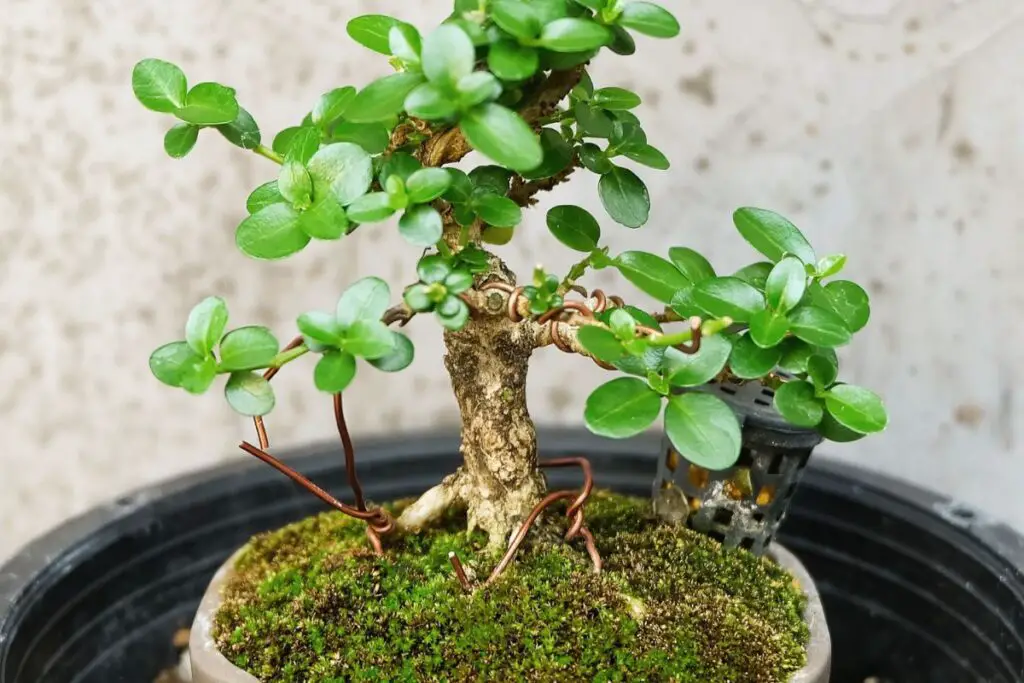
Propagation Techniques
Stem propagation is a popular way of increasing your jade plant collection. As discussed above, it can also be used for bonsai training.
In the case of root and stem rot, which renders the stems non-viable for propagation, you can collect healthy terminal leaves to grow new jade plants. However, the process can take significantly longer.
Here’s the best way to propagate jade plants from leaves:
- Collect leaves 1-2 days after watering your plant to ensure the cuttings are well-hydrated.
- Choose healthy, plump leaves without signs of discoloration.
- Pinch the leaves as close to the stem as possible. Alternatively, use a sharp, sterile knife to remove the leaves. Make a thin slice along the stem to ensure each leaf has no wounds. The tiny portion of the stem attached to the leaf will help it develop roots.
- Keep the leaves in a cool, dry room to form a callus. This can take 3-7 days.
- Prepare a shallow container about an inch (2.5 cm) deep and fill it with coco peat or the standard jade soil mix.
- Dip the callused end of the leaf cuttings in rooting hormone.
- Place the leaves horizontally on the surface of the substrate. If you’re using a wide container for multiple cuttings, keep them at least an inch (2.5 cm) apart.
- Position the container in bright, indirect light. I find it more successful to root leaf cuttings if the spot is more humid (around 50-60%).
- Mist the substrate once every 2 days to keep it moist and encourage the roots to grow.
It can take 3-4 weeks for roots to develop when kept in optimal environmental conditions. Once the roots are about an inch (2.5 cm) long, you can transplant each cutting into its own pot around 3 inches (7.6 cm) wide and deep.
You can keep the plant in the same container until it becomes rootbound, which I’ll discuss in more detail below.
Repotting
Jade plants have shallow roots and they enjoy being potbound. This helps anchor the trunk to the soil to support the heavy foliage.
For younger plants (less than 5 years old), I’ve noticed that they do better when repotted once every 2-3 years. Mature plants, on the other hand, can stay in the same pot for 3-5 years with regular fertilization starting from the third year.
You’ll know that your jade plant needs repotting when you see the following signs:
- Roots poking out of the drainage holes and soil surface
- Water quickly leaking out of the drainage holes shortly after pouring it.
- The plant is not putting out new growth, even during the growing season
- Dehydrated leaves (yellow or wrinkled)
The best time to repot jade plants is in spring when they’re actively growing.
The pot size can vary depending on the age of your plant. Note that jade plants can reach up to a hundred years when properly cared for.
Here’s the guide that works best for my young jade plants and the older ones (20-30 years old) that I got from my older relatives and friends:
- 1-5 years old: 2 inches (5 cm) wider and deeper than the rootball
- 5-10 years old: 2 inches (5 cm) wider but the same depth as the last pot
- Over 10 years old: Same size as the old pot or even smaller depending on the size of the divisions.
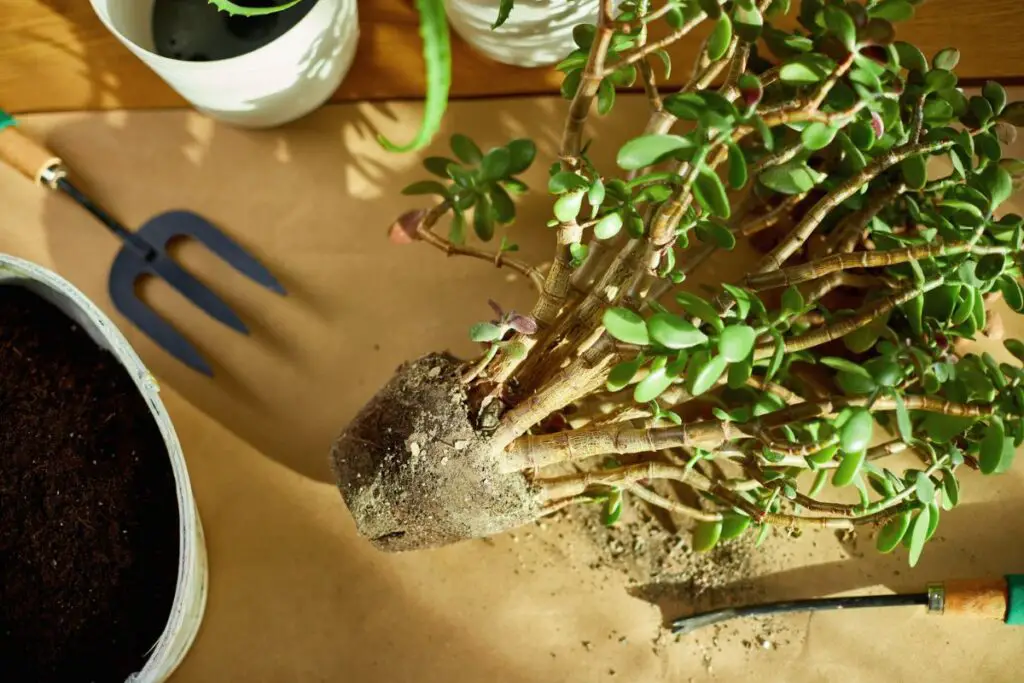
Root Pruning and Division
You can prune the roots and divide overgrown plants before repotting through these steps:
- Water the plant deeply 2 days before dividing or repotting.
- Remove the soil using a mini rake or loosen it using a wooden chopstick.
- Divisions should readily separate once the soil has been removed. If they don’t, carefully disentangle the roots. You can cut severely entangled roots using sterile shears and your jade plant will still recover.
- Cut off hair-like roots liberally until the rootball fits into the new pot but avoid cutting the thicker ones.
- Let the cuts heal and form a callus for at least 3 days.
You can then repot the plant following the planting guide above. For divisions, use a pot that’s 2 inches (5 cm) wider and deeper than the rootball.
Pest and Disease Management
Jade plants have few pest and disease problems.
Common Pests
The most common pests that attack jade plants include:
- Mealybugs: Tiny crawlers with cottony white waxy covering usually found underneath the leaves
- Scale mites: Tiny brown bumps along the stems or underneath the leaves
- Spider mites: Noticeable webbing on or below the leaf surface
These pests suck the sap from the juicy jade leaves and stems. Mealybugs and scale mites typically leave behind honeydew, a sticky, sugary substance that attracts ants and sooty mold.
On the other hand, spider mites can cause yellow or brown spots on the affected leaves, which may also appear speckled. In severe infestations, spider mites can cause leaf drops in jade plants.
You can treat pest problems using these tips:
- Manually remove the insects using cotton swabs moistened with alcohol and drop them in soapy water.
- Inspect your plants regularly and remove the pests as you spot them.
- Remove the sooty mold or webbing using a clean cloth moistened with warm water (75 °F or 24 °C).
Diseases
Jade plants become susceptible to diseases when overwatered or kept in high humidity.
Here are the common diseases to look out for:
- Root and/or Stem Rot: Thin jade roots will rot in soggy soil, requiring extensive root pruning and repotting. If the rot spreads to the stems, you might not be able to save your plant. Instead, you may grow new plants through the remaining healthy leaves.
- Bacterial Soft Rot: This disease is caused by the Erwinia bacteria and can cause the stems to rot and collapse. There’s no known cure for this disease and infected plants must be properly disposed of.
- Powdery Mildew: In jade plants, this is caused by the fungi Sphaerotheca spp. Affected leaves have tell-tale scabs on the surface. You can treat this disease using ornamental fungicides containing potassium carbonate, sulfur, or propiconazole. Check the product label and follow the application instructions carefully.
I don’t recommend using horticultural oil sprays on jade plants to treat pest or disease problems. The oil can cause leaf scorch on plants growing in direct sunlight. Relocating your plant to lower lower-light area for treatment can worsen stress and slow down recovery.
Troubleshooting Common Problems
Here are a few other problems common in jade plants:
Leaf Scorch
Jade plants are sun-loving, but too much can damage the leaves. On average, jade plants like 4-6 hours of direct sunlight daily. However, the value can vary depending on the environmental temperature.
At moderate temperatures (65-75 °F or 18-24 °C), your jade plant will thrive in more than 6 hours of direct sunlight. However, when temperatures rise and the soil is dry, the leaves will lose moisture more quickly.
The dry leaves will then get brown on black spots on the sun-exposed surface.
You can fix this problem and avoid reoccurrence through the following tips:
- Give your outdoor jade plant partial shade during hot and dry afternoons, especially when temperatures are expected to rise above 90 °F (32 °C).
- Check the soil moisture more frequently and deeply water your plant as needed.
- Rotate your potted jade plant regularly to avoid prolonged exposure to sunlight.
Lack of Flowers
Jade plants don’t often bloom indoors, but when they do, it’s a sight to behold. They have white or pinkish, star-shaped flowers that spread profusely.
To encourage your plant to bloom, you need to meet the following criteria:
- The plant is at least 3 or 4 years old.
- It receives at least 4 hours of direct sunlight daily in spring and summer.
- The soil has enough nutrients (NPK) during the growing season.
- The evening temperature in the fall is in the lower 50 °F (10 °C).
In addition, ensure your plant receives adequate water and is free from pests and diseases.
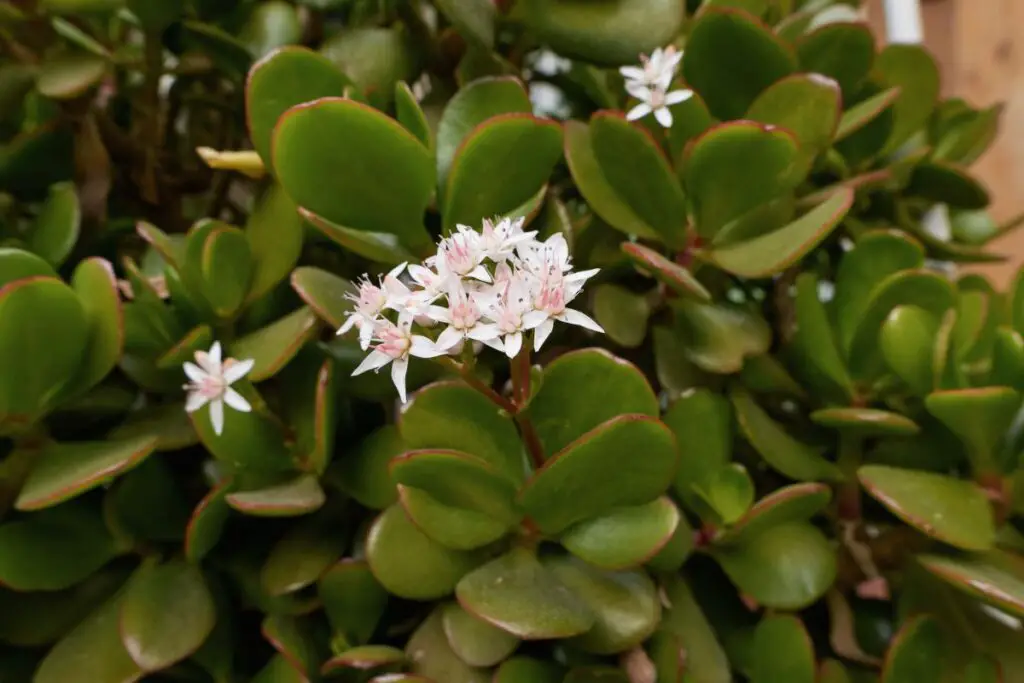
Red Leaf Tips
The red tips on jade plant leaves might seem attractive because they bring contrast against the green foliage. However, don’t confuse this with the red or orange tips of colored cultivars.
Red tips on classic green jades indicate stress due to too much light and heat. Left unattended, this can lead to leaf scorch or dehydration.
When you notice this symptom on your jade plant, give it some shade at midday. Alternatively, move it to an area with a slightly lower light level. Do this gradually over the course of one week to prevent shock.
For instance, move your plant a few feet (+ 0.6 m) away from direct sunlight for an hour a day. On the 5th-7th day, you can permanently place your plant in bright, indirect light.
Stunted Growth
On average, jade plants can grow 2-6 inches (5-15 cm) annually, depending on how well you care for them.
If your plant is not putting out new growth even during the growing season in spring and summer, it could be due to the following:
- Insufficient light
- Over- or underwatering
- Nutrient deficiency
- Rootbinding
Identifying the root cause and addressing it right away will encourage your plant to grow new shoots. You can follow the care tips I listed above for optimal growing conditions.
Leggy Stems
As sun-loving plants, most jades will develop leggy stems that lean toward the light source when they don’t receive enough sunlight.
Classic green and variegated jades prefer bright, indirect light. However, they may also become leggy in lower light conditions.
You can treat the problem with these tips:
- Prune the leggy growth using sterile shears.
- Gradually increase your plant’s light exposure. Move it a few feet (+ 0.6 m) closer to the window for an hour daily. Keep it in its new spot after 5-7 days.
- Rotate the pot regularly to avoid leaf scorch or shock from relocation.
Final Thoughts
Jade plants are one of the most resilient and longest-living houseplants. They’re also easy to propagate and share with friends or future generations.
They may survive dry conditions longer due to their succulent leaves and stems. However, they’re likely to shed leaves when chronically over- or underwatered, become leggy in low light, or get sunburnt in intense sunlight.
Explore different possibilities when growing jade plants by turning them into miniature trees or bonsai.
Let us know about your experience in growing different jade plant varieties and share some expert tips in the comments.

